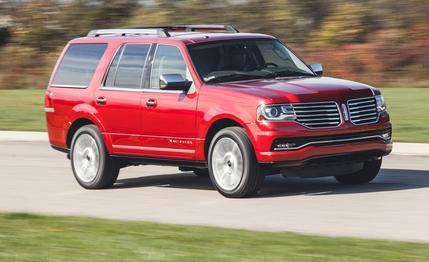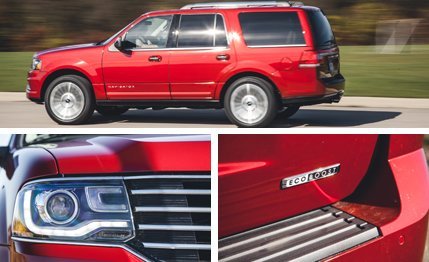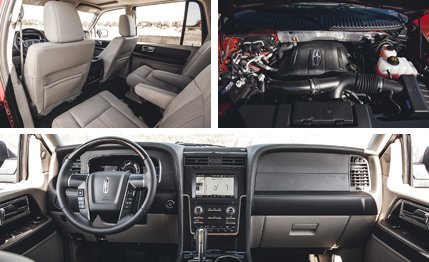
 Instrumented Test
Instrumented Test
Ford has dropped $2 billion on developing new Lincolns in the past few years and promises to keep spending on its luxury division at the rate of $1 billion annually for the next five. But the brand’s big-daddy Navigator full-size SUV won’t really benefit until a full replacement—with aluminum body panels and on the new F-150 platform—gets here in 2017. That’s 10 years after the current generation arrived for ’07 alongside what was then an also-new Cadillac Escalade. General Motors just redesigned this SUV’s primary rival, so a few Lincoln pennies were dropped on the Navigator to freshen it for 2015.
Only the nose and tail change outside; the grille has horizontal bars similar to those on newer Lincolns, but the resemblance is remote—it looks more like a chromed evolution of the long-dead Oldsmobile Bravada’s grille than it does the swoopy wings of the smaller MKC crossover. Slathering LEDs all over lends the Navigator a touch of modernity, but the net effect is akin to dabbing fresh butter on day-old bread. The interior upgrades are more effective, and we appreciate the actual knobs and buttons for primary functions like volume control, tuning, and climate-control adjustments. Most significant, a new powerplant and suspension improvements finally make the 2015 Navigator the vehicle it should have been in, say, 2012.
We hadn’t track-tested a Navigator since a 2007 model stumbled to dead last in a five-way comparison test. At the time, it was the only contender that needed longer than 8.0 seconds to get to 60 mph, the top of a long list of shortcomings. For 2015, the 3.5-liter V-6 EcoBoost supplants the old 5.4-liter V-8 as the standard (and only) engine, so horsepower leaps from 310 to 380 and torque rises from 365 to a robust 460 lb-ft. That puts the Lincoln down by 40 horsepower but dead-even on torque with the Escalade. At the track, EcoBoost pares more than two seconds off of that previous 0-to-60-mph time, now requiring 6.2 seconds, which is only a tenth behind the new Escalade. The quarter-mile run took 14.9 seconds at 93 mph, also a bit behind the Cadillac but far better than the 16.3 at 86 that the old V-8 could manage. The boosted six doesn’t yield anything to the V-8 on towing capacity, either, retaining a 9000-pound max rating (4WD models like this example are rated for 8600 pounds).


The engine transplant improves EPA fuel-economy ratings by 2 mpg across the board, with this four-by-four model boasting a 17 mpg combined rating versus 15 last year. Our test returned a 15-mpg average; we saw 16 mpg in the 2007 model, but that was over 900 miles with a lot of highway cruising. This test was shorter and involved more urban driving, so call it even. Still, this isn’t the first time we’ve found one of Ford’s EcoBoost engines coming up short in the real world against the regulatory ratings.
This example was equipped with Lincoln’s “Reserve” equipment group, a $6850 add-on that brings motorized hideaway running boards, premium leather for all three rows of seats, Lincoln Drive Control (electronically adjusting shock absorbers), and a few other tidbits. The Reserve package announces itself with 22-inch chrome wheels wearing 285/45 all-season tires, so large they protrude beyond the wheel wells when viewed from the nose—it looks almost like you could drive up to a pole and miss it with the bumper but hit it with the tire. The whole donk fad may be fading if they’re offering the look on a factory-built Lincoln. Our road warriors also estimated that each wheel-and-tire combo weighs more than 90 pounds, saying they were definitely heavier than the like-size wheels on our long-term GMC Yukon XL Denali.
Whatever you think of how they look, putting more modern, wider rubber on the ground helps. This Navigator plowed relentlessly around the skidpad but grip improved to 0.74 g from the abysmal 0.65 g we recorded in the V-8 model. The new figure nearly matches the Escalade’s lateral grip, and the Lincoln needed “only” 182 feet to stop from 70 mph, 13 shorter than the Cadillac.


There’s also new electric power-assisted steering and the adjustable suspension, and together they mitigate some of the sensation that you’ve slipped backward in a 20-year time warp. There’s no disguising the Navigator’s size or mass, but when the road curves, the 2015 version fumbles and flails around less than before. GM’s fresh SUVs feel nimbler (in part thanks to weighing a lot less), but the Lincoln can hold its head up in the presence of an Infiniti QX80. It’s also a lot quieter than it used to be, especially noteworthy in that even the enormous wheels no longer send intrusive bump noises into the cabin.
The strongest arguments Lincoln can offer to choose the Navigator over other, more modern body-on-frame SUVs that seat up to eight? Railroad-boxcar levels of interior capacity, high gross-vehicle-weight ratings, and serious towing chops. If that list checks all your boxes, you’ll need only to decide if the blingy luxury trim justifies the Navigator’s price premium over its Ford Expedition platform-mate, which was similarly updated for 2015. Dearborn did make a stab at differentiation by dialing up another 15 horsepower and 40 lb-ft for the Lincoln’s version of the EcoBoost engine.
For those buyers who need the space or hauling capacity, this may keep Lincoln on shopping lists for a couple of years. For anyone else, the aluminized successor can’t come soon enough.